How to Choose Eyeglass Lenses
Possibly the most important part of the eyewear buying process is choosing the right lenses. The lens material and lens coating contribute to how well you see and how happy you are with your eyeglasses. With so many options available on the market today, it can be difficult to decide which type of eyeglass lens is best for you.
This guide to eyeglass lenses will help you better understand what lens treatment options are available to you and help you choose the best option for your lifestyle.
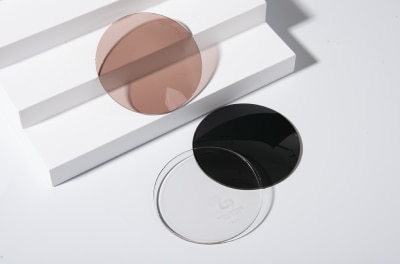
The Right Eyeglasses Lenses for Your Visual Needs
Before focusing on eyeglass lens material and special coatings, you must determine which prescription eyeglass lenses will best correct your vision. Depending on your visual needs, you may need either single-vision or multifocal lenses.
Single-Vision Distance
Many people can sufficiently correct their distance or near vision with single-vision lenses.
If you are nearsighted — which means you see clearly up close while distant vision is blurry — you will likely need a single-vision lens to correct your vision. Single-vision prescriptions for people with nearsightedness begin with a (-) in front of the number. Your eyeglass lens will be concave, or curve inward, to correct your distance vision properly.
Single-Vision Reading
Reading lenses are designed to help you see things up close — typically between 30 cm and 40 cm (11.8 to 15.8 inches) from the face. They are appropriate for people with farsightedness, which means your distance vision is clear while your near vision is blurry.
Prescriptions that improve near vision begin with a (+) and are followed by a number. The lenses are convex, or curve outward, to properly correct farsightedness.
Progressive Lenses
If you have difficulty seeing at near and far distances, you may need progressive, bifocal, or trifocal lenses (also called multifocal lenses). These prescription eyeglass lenses correct your vision at near, intermediate, and far distances.
Progressive Lenses are designed to seamlessly incorporate distance, middle, and near vision correction. Because a progressive lens is created specifically for you, they can correct any prescription combination without the visible horizontal line seen with bifocals.
While progressives can take some time to get used to, many people prefer them because they provide clear vision at all distances without any “image jumps” — all with a more youthful look. And once you’re accustomed to them, progressives are often more comfortable than other types of multifocal lenses.
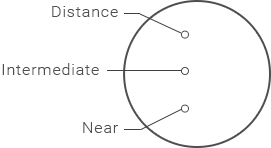 Progressive Lenses
Progressive Lenses
Bifocal Lenses
Bifocal lenses are multifocal lenses that correct both near and long-distance vision. This is achieved by combining two prescriptions into a single lens. The upper part of the lens is designed to correct distance vision, while the bottom portion is meant to correct up-close vision.
These lenses are an excellent choice for people who need both distance correction and reading glasses. With bifocals, you no longer need to carry two pairs of glasses wherever you go. They’re also a good option for people who aren’t able to adapt to progressive lenses.
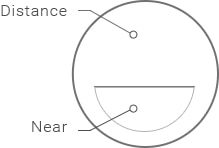 Bifocal Lenses
Bifocal Lenses
Lens Coatings, Tints & Other Options
Special types of lens coating can enhance your optical lens by helping you look better and see better. To better understand the options available to you, we’ve listed some of the coatings available on our site and what they can do for you.
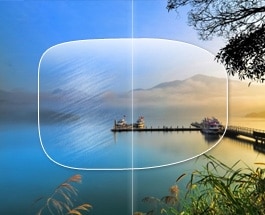
Anti-Scratch Coating
Anti-scratch coating defends your lenses against scratches from everyday wear and tear, and helps reinforce them against accidental drops. While this coating is useful for any prescription lens, it’s especially important to have on safety glasses and goggles worn in certain professions.
Because anti-scratch coating is so important for lenses, Eyebuydirect includes it for free with all of our glasses.

Anti-Reflective Coating
Anti-reflective (AR) coating is another must-have for eyeglass lenses. It helps you see better by reducing glare, halos around lights, and reflections on the back of your lenses. This comes in especially handy when driving at night or viewing a digital screen.
It also makes your lenses look better by reducing the amount of light reflected off the front of the lens. This essentially makes lenses invisible, which improves their appearance in photographs, on video calls, and in person.
Anti-reflective coating is especially important for people with high-index lenses, as these lenses have a higher refractive index. An increased refractive index means the prescription lens will reflect up to 50% more light than a standard lens. This results in more glare unless the lenses have AR coating.

Light-Adjusting Lens Technology
This built-in technology changes the tint of your lenses depending on the amount of UV light they are exposed to. They darken outside and become clear inside. This helps protect the wearer's eyes from harmful UV rays and direct sunlight, which provides clearer, safer vision.
While this coating cannot be added to sunglass lenses, nearly all new eyeglass lens materials and designs can be created with light-adjusting lens technology built in.
We offer premium Transitions™ lenses and basic photochromic lenses — both of which are excellent options for those seeking light-adjusting lenses.
People who switch from indoor to outdoor environments frequently will benefit from photochromic lenses. Transitions™ lenses offer the same amount of protection as sunglasses, while also providing exceptional indoor clarity within a single pair of glasses.
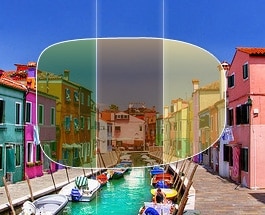
Color Tint
Whether the goal is extra visual clarity, or simply to add some personality to your lenses, a color tint coating can make it happen. Many people choose to add a hint of color to their lenses to help them see better, or to add some flair to their eyewear.
We offer over ten colors and three intensities for you to choose from, giving you plenty of options. Keep in mind that color tints cannot be added to polarized or photochromic lenses.
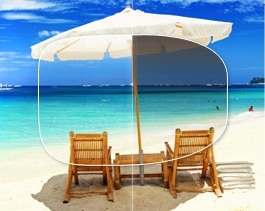
Gradient Tint
A gradient-tint lens coating is an excellent choice for sunwear. These lenses have a dark tint at the top of the lens that lightens progressively as it goes toward the bottom. The resulting lens gives the wearer plenty of sun protection, as well as privacy, but offers varying degrees of incoming light.
If you’re looking for sun protection, but are uncomfortable with uniformly dark sunglasses, consider a gradient tint coating instead. It’s important to note that gradient tints are only applicable to lenses for a frame height greater than 36 millimeters.

Polarized Lenses
Polarization reduces the glare reflected from certain surfaces, like water, snow and roads. This glare can be distracting and potentially dangerous, which is where polarized lenses come in handy.
The glare reduction properties of polarized lenses provide improved visual comfort for people who have light sensitivity or increased exposure to bright light. This makes them a great choice for avid travelers, water and snow sports enthusiasts, and people recovering from cataract surgery.
Eyebuydirect’s polarized lenses come in standard dark green, dark brown, or dark gray tints, so you have options for the look of your lenses.
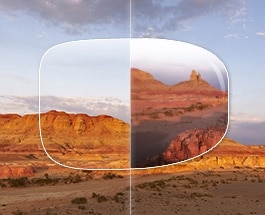
Mirrored Tint
Mirrored lenses are a functional and fashionable option to give your sunglasses a little extra flash. This reflective coating comes in gold, silver and blue.
Take a look at mirrored tints if you’re in search of a more mysterious style. Athletes should also consider these coatings, since mirrored tints are highly sought after in sports and performance sunglasses.

Water-Repellent Coating
All eyeglass wearers dread getting rain or water on their eyeglasses. Droplets can leave behind smudges and dirt on your lenses, and cleaning them properly can be a hassle — especially in rainy weather.
Water-repellent coatings keep water droplets, dirt, and smudges off your lenses, which helps to maintain their cleanliness and reduces the need for you to clean them regularly. Lenses with this premium coating stay crystal-clear up to twice as long as your normal eyeglass lenses.
If you find yourself having to clean your lenses often, we recommend looking into this lens coating to help keep your lenses as clear as possible!
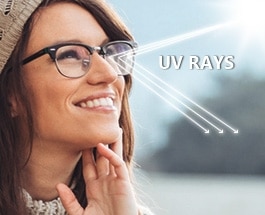
UV-Protective Coating
Exposure to the sun’s harmful UV rays is associated with many age-related eye problems, such as cataracts and macular degeneration. Because of this, doctors encourage people to protect their eyes from UV radiation.
UV-protective coating is important to have on your eyeglass and sunglass lenses. By deflecting harmful UV rays from the sun, this invisible UV-protective coating works like sunscreen for your eyes.
Blue Light Filtering Coating
Blue-violet light can be potentially damaging to our eyes on a long-term basis, due to cumulative exposure. The issue is cumulative excessive damage, not because of too much exposure to blue-violet light on one day. It happens over time.
The biggest source of blue-violet light is the sun outdoors and indoors through windows, but it's also emitted by some digital screens.
This part of the visual spectrum is a short- wavelength light. Unlike blue-turquoise light, which is healthy and beneficial for us, blue-violet light, such as the high-energy visible (HEV) light from backlit screens and artificial lighting such as fluorescent, can be damaging to our eyes through excessive exposure.

Lens Index Options
The index of your lens, also referred to as the index of refraction or “refractive index,” is a number that indicates how the eyeglass lens material bends, or refracts, light. The higher the refractive index of a lens, the more slowly light moves through it, and the more the light bends. Higher-index lenses are typically thinner and will perform the same as a thick set of standard low-index lenses.
Additionally, higher-index lenses are able to handle higher prescriptions. If you have a particularly strong prescription, a lens with a higher index may be a better choice for you. Eyebuydirect offers lenses with an index up to 1.74.
When choosing your lens index, it will help to have your vision prescription ready so you can check your SPH (sphere) and CYL (cylinder) values. The farther your SPH and CYL values are from zero, the stronger your prescription and the higher-index lens you may need.
-

1.5 Index — Standard Lens
If you are looking for an economical option for your lenses and have a weaker prescription, standard plastic lenses may be right for you. These single-vision lenses are the most basic option we offer and come free with all Eyebuydirect frames.
This index is most suitable for prescriptions with an SPH correction of +/-2.25 and below, and/or a CYL correction of +/-2.00 and below.
-

1.57 Index – Thin and Light Lens
For people with somewhat stronger prescriptions, these lenses may be a better choice than the standard lenses. This thinner, lighter lens is stronger than its 1.5-index counterpart. They can handle SPH corrections between +/-2.50 and +/-5.00, and CYL corrections of +/-3.00 and below.
-

1.59 Index – Polycarbonate Lens
Polycarbonate lenses are the most durable and impact-resistant lenses we offer, and they come with a 100% UV-protective coating.
If you are looking for glasses for children, or tend to spend your time outside, we strongly recommend polycarbonate lenses. They are tough enough to hold up against the wear and tear kids usually inflict on their eyeglasses.
The 1.59-index lenses are suitable for SPH corrections ranging from +/-4.25 to +/-6.75, and CYL corrections between +/-2.25 and +/-3.00.
Interested in our polycarbonate lenses? UV protection is built right in!
-

1.6 Index – Super-Thin Lens
These stylish, super-thin lenses are an excellent choice for people with strong prescriptions or particularly thin frames. Like 1.59-index polycarbonate lenses, these lenses are suited to people with SPH corrections between +/-4.25 and +/-6.75, and CYL corrections between +/-2.25 and +/-3.00.
-

1.67 Index – Ultra-Thin Lens
These thin, lightweight lenses ensure your eyes do not look distorted from a higher prescription. If you have a particularly strong prescription, this is likely the best choice for you. We typically recommend these lenses for people with SPH corrections between +/-7.00 and +/-9.00, and CYL corrections between +/-3.25 and +/-4.00.
-

1.74 Index – As-Thin-as-Possible Lens
Our thinnest corrective lens is designed for the highest-powered prescriptions. They can provide a powerful vision prescription in a thin lens, reducing the “coke bottle” appearance you often get with high-prescription lenses. These are best for prescriptions with SPH corrections of +/-9.25 and above, and CYL corrections between +/-4.25 and +/-6.00.
Which Type of Eyeglass Lens Is Best for Me?
Your vision is critical to your everyday life, which is why you need corrective lenses that provide improved visual comfort and clarity. With the help of these guidelines, you can make an educated decision on the type of lenses that will best suit you and your lifestyle.
Still not sure what lenses you need? In a comprehensive eye exam, your eye doctor will make sure your eyes are healthy and determine your current eyeglasses prescription. You’ll also have a chance to speak with an eye care provider about what lenses best suit your vision needs.
Visit Eyebuydirect’s vast catalog of glasses and look at our variety of lens options today!
Shop Eyeglasses





